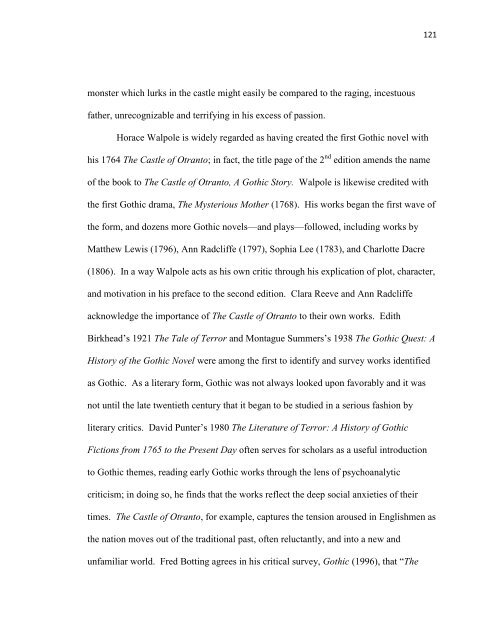SUMMERS, KAREN CRADY, Ph.D. Reading Incest - The University ...
SUMMERS, KAREN CRADY, Ph.D. Reading Incest - The University ...
SUMMERS, KAREN CRADY, Ph.D. Reading Incest - The University ...
Create successful ePaper yourself
Turn your PDF publications into a flip-book with our unique Google optimized e-Paper software.
121<br />
monster which lurks in the castle might easily be compared to the raging, incestuous<br />
father, unrecognizable and terrifying in his excess of passion.<br />
Horace Walpole is widely regarded as having created the first Gothic novel with<br />
his 1764 <strong>The</strong> Castle of Otranto; in fact, the title page of the 2 nd edition amends the name<br />
of the book to <strong>The</strong> Castle of Otranto, A Gothic Story. Walpole is likewise credited with<br />
the first Gothic drama, <strong>The</strong> Mysterious Mother (1768). His works began the first wave of<br />
the form, and dozens more Gothic novels—and plays—followed, including works by<br />
Matthew Lewis (1796), Ann Radcliffe (1797), Sophia Lee (1783), and Charlotte Dacre<br />
(1806). In a way Walpole acts as his own critic through his explication of plot, character,<br />
and motivation in his preface to the second edition. Clara Reeve and Ann Radcliffe<br />
acknowledge the importance of <strong>The</strong> Castle of Otranto to their own works. Edith<br />
Birkhead’s 1921 <strong>The</strong> Tale of Terror and Montague Summers’s 1938 <strong>The</strong> Gothic Quest: A<br />
History of the Gothic Novel were among the first to identify and survey works identified<br />
as Gothic. As a literary form, Gothic was not always looked upon favorably and it was<br />
not until the late twentieth century that it began to be studied in a serious fashion by<br />
literary critics. David Punter’s 1980 <strong>The</strong> Literature of Terror: A History of Gothic<br />
Fictions from 1765 to the Present Day often serves for scholars as a useful introduction<br />
to Gothic themes, reading early Gothic works through the lens of psychoanalytic<br />
criticism; in doing so, he finds that the works reflect the deep social anxieties of their<br />
times. <strong>The</strong> Castle of Otranto, for example, captures the tension aroused in Englishmen as<br />
the nation moves out of the traditional past, often reluctantly, and into a new and<br />
unfamiliar world. Fred Botting agrees in his critical survey, Gothic (1996), that “<strong>The</strong>
















